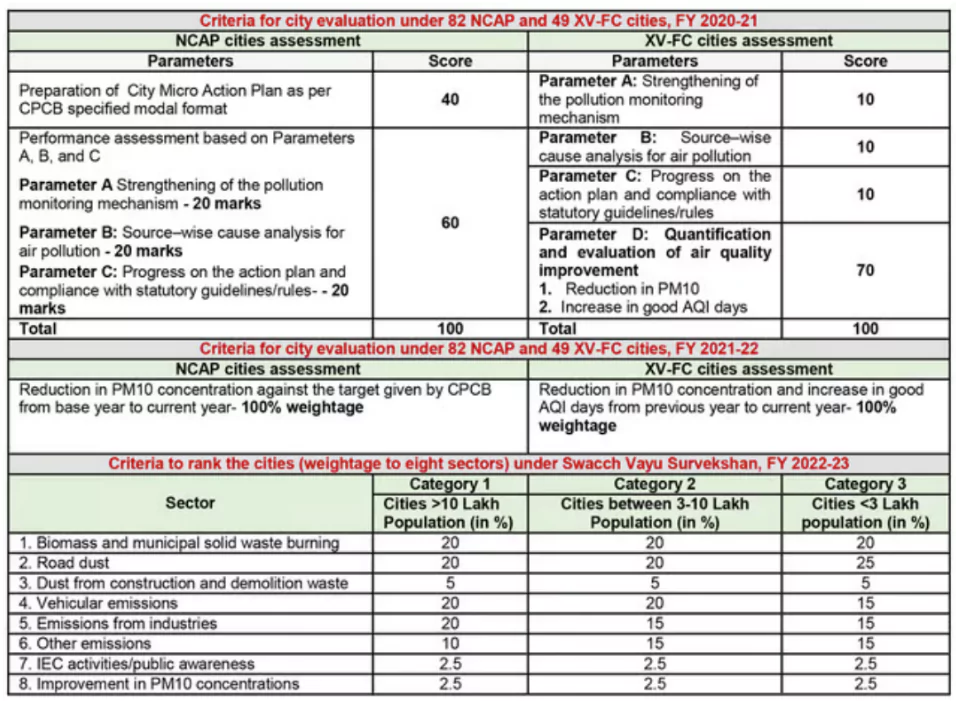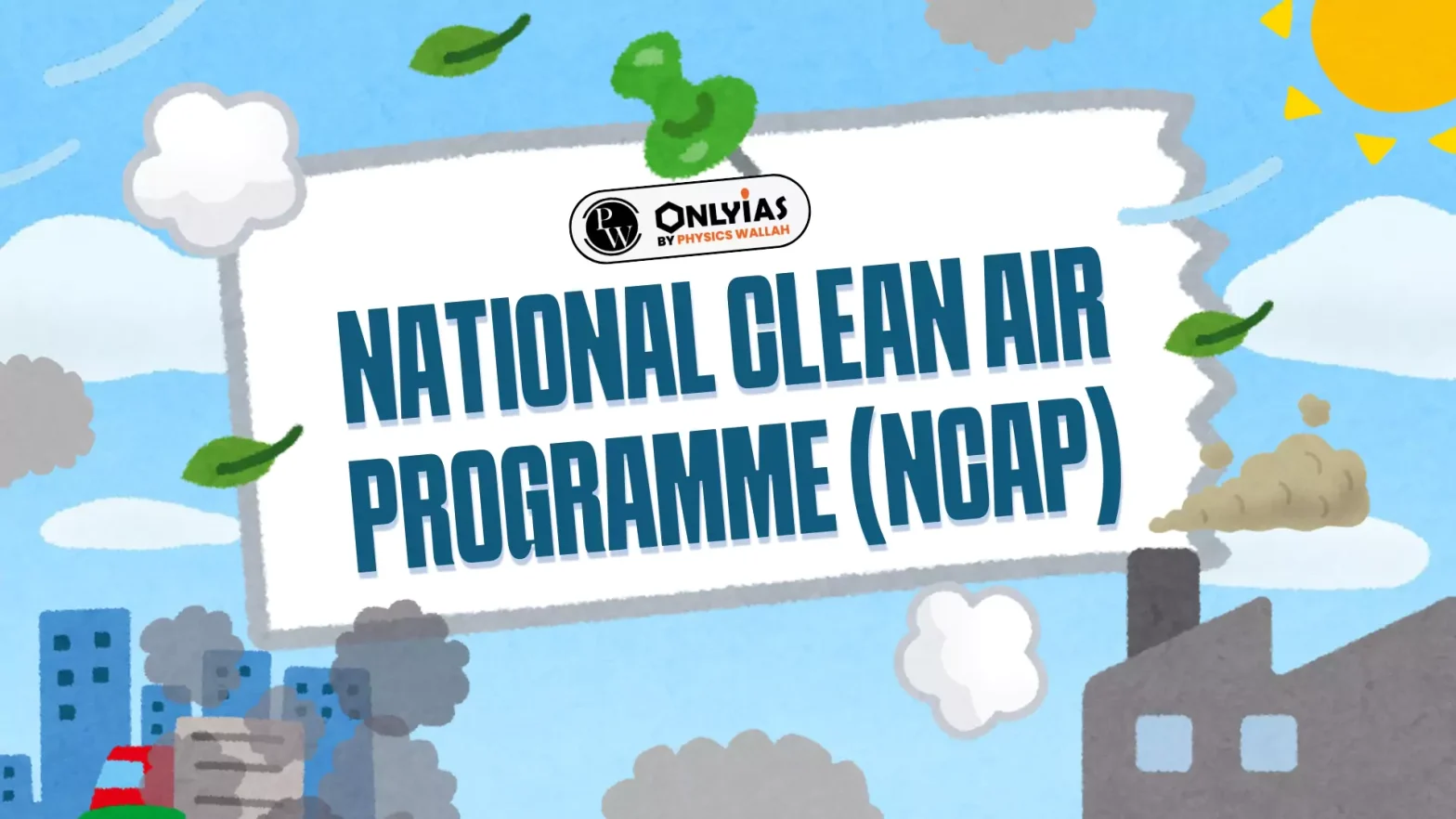The Delhi-based Centre for Science and Environment recently evaluated the metrics used in the National Clean Air Programme (NCAP).
They found the current methods for assessing city performance to be inadequate.
About National Clean Air Programme (NCAP)
- Nodal Ministry : The Ministry of Environment, Forest and Climate Change (MoEFCC).
- Launch: It was launched in January 2019.
- It is the first national effort to create a framework for air quality management.
- Objective: Aims to reduce the levels of coarse particles (PM10) and fine particles (PM2.5) by at least 20% within five years, using 2017 as the base year.
- Target Cities:
- The programme focuses on 131 cities, Includes 123 non-attainment cities (NACs) and additional million-plus cities (MPCs).
- Non-Attainment Cities (NACs): These are the cities Identified for not meeting national ambient air quality standards (NAAQS) for five consecutive years.
- Million-Plus Cities (MPCs): Identified by the 15th Finance Commission (XV-FC) for receiving performance-based grants for air quality improvement.
- Overlap: 34 out of 42 MPCs are also covered under NCAP.
Enroll now for UPSC Online Course
- Significance:
- Enhanced Air Quality Monitoring:
- It develops a comprehensive and reliable network for monitoring ambient air quality nationwide.
- Ensure a robust database for accurate data collection.
- Efficient Data and Public Outreach:
- Implement effective data dissemination strategies.
- Foster public participation in planning and implementing government policies on air pollution.
- Promote timely measures for the prevention and mitigation of air pollution.
- Air Pollution Management: Create and implement practical plans for preventing, controlling, and reducing air pollution.
- Effectiveness of the NCAP: NCAP has been very effective at some places but failed at other places. Therefore, it shows mixed results
- PM10 levels: Under this program, 82 cities were given an annual target of 3-15% reduction in PM10 levels.
- City performance:
- Worst performers: Durgapur and several cities in Maharashtra have seen rise in PM10 Levels. For example, Mumbai experienced a 37% rise in PM10 levels from 2019 to 2023.
- Best performers: Varanasi has shown notable improvements with a decrease in PM10 Levels by 63%.
- Talcher and Agra have also shown notable decreases in PM10 levels.
- Deterioration: The study conducted by Climate Trends and Respirer Living Sciences showed that PM10 levels have deteriorated in 22 cities out of 46 cities tracked over five years.
- Only 8 cities achieved the initial target of 20- 30%.
- High Pollution Levels: Most cities are so polluted that they crossed National Ambient Air Quality Standards (NAAQS) and the World Health Organization’s guidelines.
The Need for a New Performance Assessment Framework
To accurately evaluate the performance of the 131 cities under NCAP, XV-FC, and SVS assessments, there is a need for new, robust metrics.
-
Current Limitations in Evaluation
- Narrow Focus: Current evaluations mainly use PM10 levels and overall air quality data, often ignoring specific sector initiatives.
- Unfair Labeling: Cities may be unfairly marked as non-performers if PM10 levels haven’t improved, despite significant efforts in other areas.
-
Issues with Current Weightage
- Swachh Vayu Survekshan (SVS): Assigns only 2.5% weight to improving PM10 levels, underrepresenting its importance.
- Assessment Discrepancies: The second assessment focused fully on PM10, but the low weight in SVS undermines the core goals of NCAP.
Check Out UPSC CSE Books From PW Store
-
Need for a Comprehensive Framework: A comprehensive framework should be established that includes:
- Sector-Specific Actions: Acknowledging and evaluating specific initiatives taken in various sectors.
- Multi-Pollutant Approach: Use data for both PM10 and PM2.5 data to provide a more holistic assessment.
-
Shift in Focus for Public Health
- From a public health perspective, the focus should shift towards the more harmful PM2.5 particles.
- Establishing PM2.5 as the benchmark for performance-linked funding would ensure a more accurate and fair assessment of cities’ efforts and progress in improving air quality.
- This shift would align the evaluation with the actual impact on public health and ensure a more comprehensive understanding of air quality improvements.
Challenges in Evaluating 131 NCAP Cities
-
Initial Phase Disparities
- In the first year of the National Clean Air Programme (NCAP), the evaluation process faced challenges due to incomplete preparations. By September 2021:
- City Action Plans: Out of 131 cities, 125 received approval for their action plans.
- Micro Action Plans: Only 58 cities submitted their micro action plans.
- Source Apportionment Studies: Only 12 cities completed these studies, while 72 were ongoing, and 42 were still in the tendering stage.
- These discrepancies highlighted significant differences among the cities, with many lagging in crucial preparatory steps, such as developing comprehensive action plans and detailed source apportionment studies.
- Flaws in Assessment Methodology: During the second evaluation phase, the method used for assessing XV-FC cities had some limitations:
- Exclusion of Extreme Data: The evaluation removed 2% of the most extreme PM10 concentration data (seven to eight days out of 365), which normalized the data.
- This approach moderated the situation and failed to fully reflect the actual reduction in PM10 levels and the increase in good air quality days.
- Data Manipulation: Excluding extreme pollution levels (outliers) skewed the true picture of air quality and its impact on health.
- Limited Focus: Emphasis on average annual PM10 levels ignored short-term pollution spikes, which are harmful to health.
- Exclusion of Unhealthy Exposures: By excluding these extreme situations, the evaluation did not account for the impact of unhealthy exposures on human health.
 Insufficient Weighting: The low importance assigned to PM10 reduction undervalued efforts to improve air quality.
Insufficient Weighting: The low importance assigned to PM10 reduction undervalued efforts to improve air quality.- Oversimplified Comparison: Ranking cities based only on population, without considering other factors, led to unfair comparisons.
-
Disconnected Assessment Results
- Inconsistent Rankings: Different methods produced varying rankings for the same cities, making it hard to identify effective strategies.
- Lack of Correlation: No clear link was found between a city’s pollution reduction actions and actual improvements in air quality.q
Key Legislative Acts for Air Quality Management in India
- The Air (Prevention and Control of Pollution) Act, 1981: India’s first major law to tackle air pollution.
- Key Provisions: Establishes Central and State Pollution Control Boards to monitor air quality and implement pollution control measures.
- The Environment (Protection) Act, 1986: It was created to address environmental issues following the Bhopal Gas Tragedy.
- Key Provisions: Allows the central government to regulate all forms of pollution and set standards for emissions and waste discharges.
- The Motor Vehicles Act, 1988: Aims to control vehicle emissions, a major source of air pollution in cities.
- Key Provisions: Requires vehicles to use pollution control devices and undergo regular emission tests.
- The National Green Tribunal Act, 2010: Established a specialized tribunal for handling environmental cases.
- The Commission for Air Quality Management in National Capital Region and Adjoining Areas Act, 2021
- Purpose: Formed to address air quality issues in the National Capital Region (NCR) and nearby areas.
- Key Provisions: The commission can implement measures to reduce pollution from industries, vehicles, and construction activities.
Enroll now for UPSC Online Classes
Acts Related to Air as a Natural Resource
-
The Factories Act, 1948 (Amended in 1987)
- Purpose: Focuses on improving the working environment for employees.
- 1987 Amendment: Enhanced environmental concerns and extended regulations to hazardous processes.
-
The Air (Prevention and Control of Pollution) Act, 1981
- Purpose: Aims to control and reduce air pollution.
- Key Provision: Empowers the Central Pollution Control Board (CPCB) to enforce pollution control measures.
-
The Air (Prevention and Control of Pollution) Rules, 1982
- Purpose: Details the procedures for the meetings and functions of pollution control boards.
- Key Provision: Defines the powers and responsibilities of these boards.
-
The Atomic Energy Act, 1982
- Purpose: Manages radioactive waste.
- Key Provision: Regulates the handling and disposal of radioactive materials to prevent pollution.
-
The Air (Prevention and Control of Pollution) Amendment Act, 1987
- Purpose: Enhances the powers of central and state pollution control boards.
- Key Provision: Enables boards to address severe air pollution emergencies.
-
The Motor Vehicles Act, 1988
- Purpose: Regulates the transportation of hazardous waste.
- Key Provision: Ensures hazardous waste is properly packaged, labeled, and transported.
|
![]() 2 Aug 2024
2 Aug 2024

 Insufficient Weighting: The low importance assigned to PM10 reduction undervalued efforts to improve air quality.
Insufficient Weighting: The low importance assigned to PM10 reduction undervalued efforts to improve air quality.